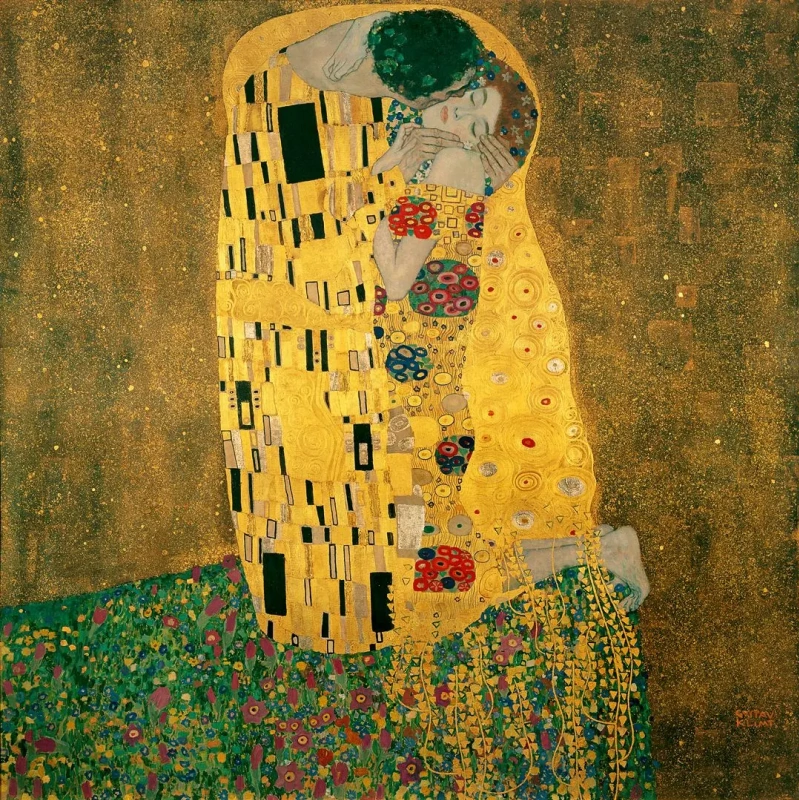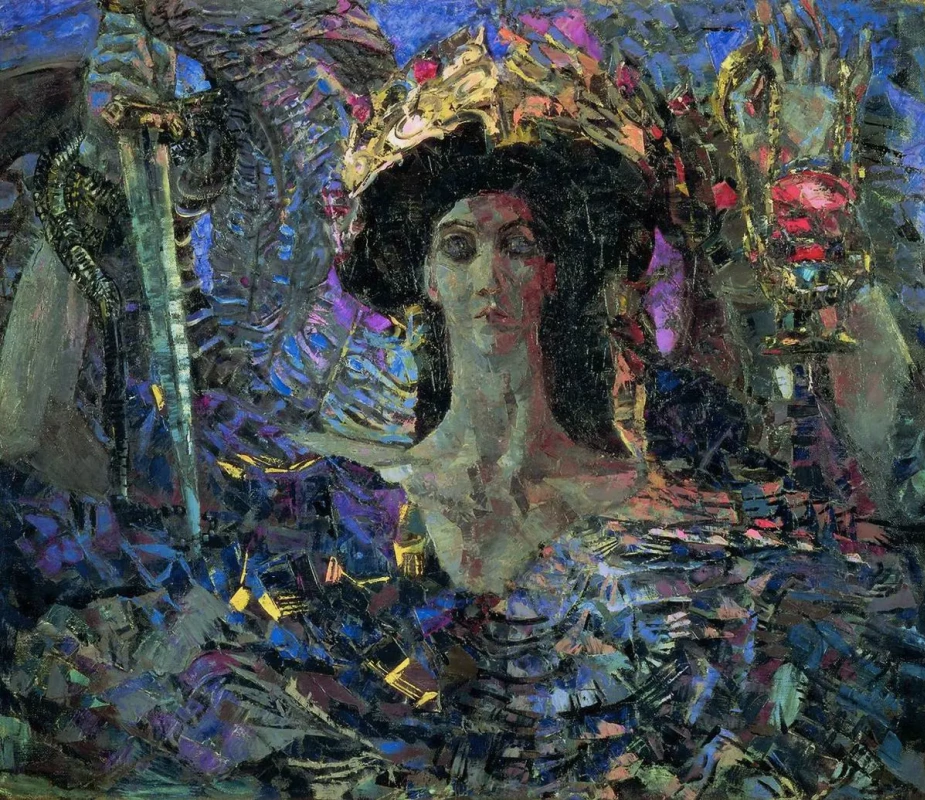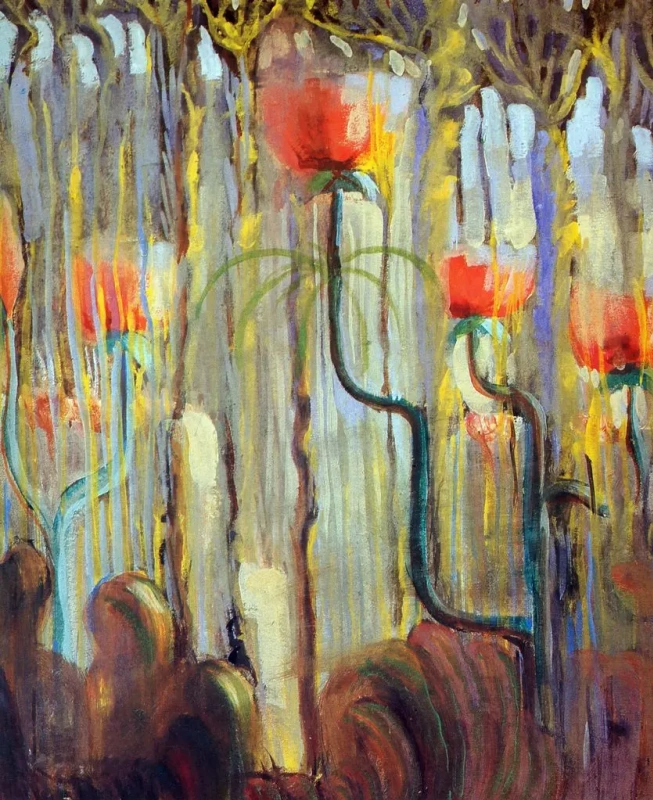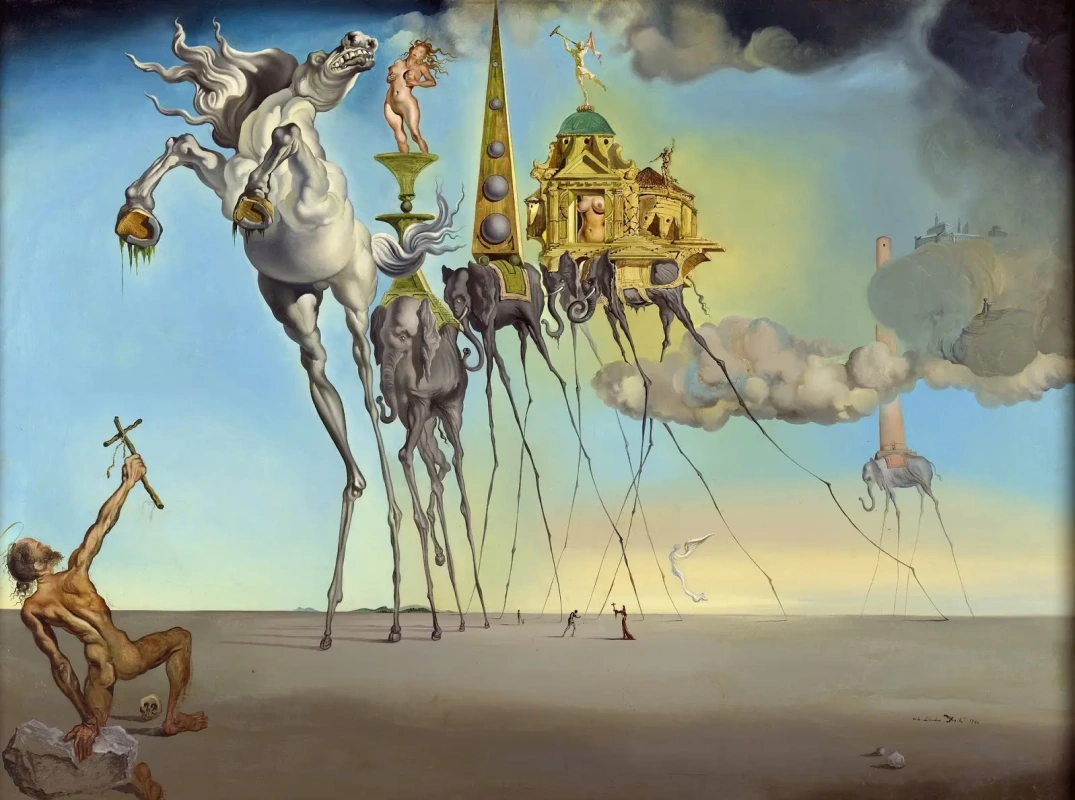Painting and music are as far apart as they are close. In an effort to convey the musical character of a situation or the sound of certain compositions, artists often depicted people playing music with instruments, and composers invented a special genre — symphonic sketch
. However, the kinship of music and painting is deeper; composition, rhythm, colour are intrinsic properties of both art and music through ages. Some artists and paintings "sound" especially bright.

Marc Chagall. The painted ceiling of the Paris Opera
What picture can "sound" richer than the canvas by Marc Chagall with an area of 220 square meters, raised above the orchestra of the Paris Grand Opera? The Chagall, in whose pictures people and animals turn into violins and cellos (1, 2) and pray for the whole world, playing music in heaven. The Chagall, whose talent as a set designer was realized in musical theatre — he created spaces for ballets and operas where artists, like his own subjects, flew, whirled and soared from an excess of feelings. The Chagall, who at the top of that painted a luxurious harpsichord by William Dowd according to an old tradition (even Rubens did it!)Everything painted on the Chagall’s ceiling expresses respect for the composers of the operas and ballets of the XVIII—XX centuries. The center is dedicated to Beethoven, Verdi, Gluck and Bizet — of course, his Carmen. The white and green parts are operatic: Pelleas and Melisande by Debussy, Tristan and Isolde by Wagner with Romeo and Juliet by Berlioz. Then goes the blue part with the Mozart’s Magic Flute and Boris Godunov by Mussorgsky. Then the ballets: classical ones — Tchaikovsky’s Swan Lake and Adan’s Giselle — in the yellow part, and the innovative ones — The Firebird by Stravinsky and Daphnis and Chloe by Ravel — in the red part. For music lovers, this sequence evokes a lot of stories and musical links.
Little wonder that the French Minister of Culture (writer and art historian) André Malraux, having decided to renovate the auditorium of the country’s main opera house, addressed this order to Chagall. While painting 12 canvas wedges, each 8.5 meters long, the 77-year-old painter climbed onto a stepladder and spent 200 kg of oil paint in a year — he really needed buckets of it. Chagall refused to receive his fee for this colossal work, explaining that he was grateful to France, which "gave him citizenship, freedom of creativity and the honour of such an order".
In a greatly reduced form, the Chagall’s ceiling looks like a precious porcelain plate, and in 2012, Swiss watchmakers produced 15 watches with enamel dials in gold cases: one model with an exact copy of the entire ceiling and 14 models with its details, each watch was dedicated to another composer. The watch ticking counts 300 clicks per minute; using this miniature metronome you can check the allegros of opera overtures and the ballet adagios.
On the new ceiling opening day, in honour of Chagall, the orchestra performed the Symphony No. 41 ("Jupiter") — the last one — by his beloved Mozart. Its beginning is wonderfully suitable for the opening of a theatre curtain, and the further 40 minutes of music are dramatic collisions of various musical themes and characters. The music was just asking to be used in a ballet, which was brought to life in 2000.
Let’s listen to the Jupiter symphony performed by the European Chamber Orchestra conducted by Nikolaus Harnoncourt:
Little wonder that the French Minister of Culture (writer and art historian) André Malraux, having decided to renovate the auditorium of the country’s main opera house, addressed this order to Chagall. While painting 12 canvas wedges, each 8.5 meters long, the 77-year-old painter climbed onto a stepladder and spent 200 kg of oil paint in a year — he really needed buckets of it. Chagall refused to receive his fee for this colossal work, explaining that he was grateful to France, which "gave him citizenship, freedom of creativity and the honour of such an order".
In a greatly reduced form, the Chagall’s ceiling looks like a precious porcelain plate, and in 2012, Swiss watchmakers produced 15 watches with enamel dials in gold cases: one model with an exact copy of the entire ceiling and 14 models with its details, each watch was dedicated to another composer. The watch ticking counts 300 clicks per minute; using this miniature metronome you can check the allegros of opera overtures and the ballet adagios.
On the new ceiling opening day, in honour of Chagall, the orchestra performed the Symphony No. 41 ("Jupiter") — the last one — by his beloved Mozart. Its beginning is wonderfully suitable for the opening of a theatre curtain, and the further 40 minutes of music are dramatic collisions of various musical themes and characters. The music was just asking to be used in a ballet, which was brought to life in 2000.
Let’s listen to the Jupiter symphony performed by the European Chamber Orchestra conducted by Nikolaus Harnoncourt:
00:00
Mozart - Symphony #41 - Harnoncourt
Kiss
1908, 180×180 cm
Gustav Klimt. The Kiss
Music is expected to have a "golden" sound in many cases: to show delight or spiritual warmth, fanfare appeal or heroic prowess. Composers of different epochs entrusted this to the instruments they had: the flickering of the smallest vibration of violins, the roar of a large harpsichord. Pure gold casting is intrinsic to all kinds of pipes and horn made of brass with different content of copper and silver. In the 19th century, the Belgian master Adolphe Sax also constructed saxhorns and saxophones (patented in 1846) of the "new silver" - an alloy of copper with nickel and zinc. Saxophones are virtuosic, orotund, melodious like a rich human voice, capable of sounding sincerely, excitedly, ironically, spicily, passionately, hotly. Especially "human" is alto saxophone. Its voice is like the voice of love.It was to this instrument that Georges Bizet entrusted the lyric solo in the overture to the performance opening of the new Parisian Vaudeville theater, the drama Arlesian (1872) by Alphonse Daudet about happy love, ruined by evil fate. In this piece of music (listen from 3:00 mark to the end), there is so much tenderness, gentleness, careful touch — dreams and admiration, waves of desire and sweetness. The saxophone melody passes twice (love is mutual!), overcoming anxiety and sadness, surrounded by soft flashes and glimpses of other shades of gold.
00:00
Bizet - L'Arlesienne - Prelude
Two kneeling figures who turned their faces away from the audience, in passionate and chaste embraces, shrouded in golden-woven clothes, in a brocade flowering meadow, in the middle of a starry universe — everyone knows Gustav Klimt’s The Kiss! His most famous painting, replicated down to the fridge magnets, crowns the "golden period" of his oeuvre. And Klimt knew he oats in the properties of gilding, as he was a jeweler’s son and a gold engraver’s brother.
The six-winged Seraph (Azrael)
1904, 131×155 cm
Mikhail Vrubel. The Six-Winged Seraph (Azrael)
In Azrael’s lining with a sword and a lamp, bells are ringing. Music has always sounded somewhere very close to Vrubel: in childhood, its source was his loving stepmother, a magnificent pianist, later in maturity — his beloved wife, a first class opera soloist. In the year of his son’s birth, Vrubel began his work Easter Voices (the angels rush over the birch grove to preach). He had to leave it until better times: the depressed mood of the artist turned into a crushing depression with several periods of improvement, one of which was marked by the beginning of his Azrael, which Vrubel painted just on the unfinished canvas. The six-winged herald of death met Vrubel after all his "suffering, mournful, powerful and dignified" Demons ("Seated", 1890, "Flying", 1899 and "Fallen", 1902), all the prophets and angels.Vrubel began to paint the second version of the six-winged Seraphim with a self-portrait in profile, from the side, already losing his sight. And this first, the main Azrael, the inevitable, demanding, unbearably shining one, with cold sparkling sword and raspberry warm lamp in raised hands, appeared to him as the "last categorical imperative" (according to the artist himself) bearing fearlessness before Fate. After this meeting, Vrubel lived his very difficult life completely stoically.
This work implies the rejoicing of the spirit and all the artistic delight, as well as incomprehensible Vrubel’s skill: the composition and the sparkling of Byzantine mosaics, the unique Vrubel blue glow, fiery majolica-like glitter, candid piercing gaze. And the air pulsates, as after a lightning during a thunderstorm, ceasing from a deafening crackling sound.
Trembling before his Azrael, his last big canvas, Vrubel worked all day every day.
"No one will fall asleep!" this is how Prince Calaf sang on the crucial night after he had accepted the challenge of ruthless Princess Turandot. "No one will fall asleep!" chorus echoes. This is the culmination of the final act of Giacomo Puccini’s last opera before his death. The composer paid for the utmost tension, dazzling beauty and unprecedented majesty of arias with the pain in his throat afflicted with cancer, fearing that he would not have time to finish the score. The Six-Winged Seraphim and Turandot (1926) are both unattainably imperious, blindingly solemn, indisputable, they stop the agony of pain, insomnia and looking into the abyss. The hard won prize that few creators were rewarded.
00:00
Puccini - Turandot - Nessum dorma - Domingo
Mikalojus Čiurlionis. Prelude and Fugue diptych
Čiurlionis, like nobody else, embodied the synthesis of arts, to which all the Symbolists aspired. Equally gifted and successful in musical composition and painting, he began to paint with the mind of an already established, outstanding composer, and was able to refresh the stylistic searches of artistic modernism in such a way that got on the list of the greatest innovators of abstract art. In turn, painting has modified Čiurlionis's musical pieces, making them more orderly and putting a line between his early romantic works and mature ones, in which the concentrate of sound ideas per piece is close to the famous serial technique of the composers of the Second Viennese School. All almost 400 pieces of music, as well as more than 300 paintings and drawings were created by Čiurlionis in one decade, from 1901 to 1911.The musicality of Čiurlionis's cardboards and canvases is well-rounded. Half of them are cycles with numeration, names and organization, reminding those of music genres: Sonatas (Sonata of the Sun, Sonata of the Sea, Sonata of the Serpent, Sonata of the Spring), Symphonies, Preludes and Fugues.
In addition to a quite conditional pictorial tonality, each of Čiurlionis's works contains islands of colour that form that tonality and those selected tones that demonstrate its original "chords". They have their own "timbres" - rough brushstrokes, vibrating air, and melodies showing up through lines. They also have their own gradation of colour intensity, corresponding to the sound volume.
Some paintings are assimilated with hearing choral sheet music: for example, in the Creation of the World, the fundamental bass below harmonizes with the upper voice, and the bright replicas of melody connected with them flourish in a mildly pulsating volume of the inner voices.
The laws of harmony prevail in some opuses of Čiurlionis's "pictorial music," but this harmony is mostly polyphonic: line-like subjects and parts of his paintings are fused into each other layer by layer, expanding their story with reflections, doubling and repetitions at a distance (which the artist likens to time — now all sound players are equipped with such visual graphic timer).
Prelude. From the diptych "prelude. Fugue"
1908, 60.2×71.1 cm
Fugue. From the diptych "prelude. Fugue"
1908, 62×73 cm
As befits any diptych, both parts of Prelude and Fugue share the overall tone, that is a bit gloomy, but light and transparent, implying hope: F-sharp minor or E-minor. In the Prelude (usually, this is a state "caught" by sounds or a story-teller's introduction), the silhouette of a huge boat, almost indistinguishable in a watercolour background formed by the sea and air, that can be noticed only in short brushstrokes — notes of shadow. The boat is so important because it will pass out of sight when the sun rises higher or finally sets, and the city on the coast reveals its steady polyphony. It presupposes a flexible, slow motive, which "thickens" due to the four-time repetition, with a transition to a major episode and finally taking a firm stand; but that’s only a rough outline of a future fugue. It will turn into a separate painting.
Here, in the foreground and on the horizon ("timer"), one can see the same curved motifs of the city, with its peaks of hills and spires, sometimes in several layers; however, there is another subject, which develops in its own way — yet simultaneously with the first one. Its fussy line is almost symmetrical — as if you tried to outline the carved contour of a spruce. In the distance, it is reflected with a shift in the "time scale": downs instead of ups, and vice versa. The musicians would say "the subject is presented in circulation." Also, from time to time, the contour is outlined by smaller or larger movements — the subject gets a more fractional or, accordingly, larger rhythm ("decreasing " or "increasing"). The numerous spruces are the "accelerator" of the fugue, which is called stretto: the subject is presented in one voice and then imitated in one or more other voices — higher or lower, lighter or darker. Sometimes, the spruce is blocked by an urban landscape , sometimes — vice versa; at the end, all that’s left is the city. And just as living trees are never identical to each other, so the subject in the fugue can’t be repeated literally — that’s the reason for showing its various possibilities.
At least once in their lifetime, each polyphonist composer wrote a double fugue. Let’s think that Čiurlionis had it on his mind, but used tempera instead of a musical notation to create it. So it’s impossible to play it, but you can find some analogs in the world musical heritage. For example:
- Dmitri Shostakovich, Prelude and fugue E- minor from the cycle 24 Preludes and Fugues for Solo Piano (1950−1951). This fugue is a double one. We recommend listening to it performed by Sviatoslav Richter.
— Music pieces from Čiurlionis opuses, sharing the same "spirit" - the first part (Allegro moderato) of the string quartet in C minor (listen from the start to 11:00), harsh music about oneself and the world, with enlightenments like the sun in the landscape .
Here, in the foreground and on the horizon ("timer"), one can see the same curved motifs of the city, with its peaks of hills and spires, sometimes in several layers; however, there is another subject, which develops in its own way — yet simultaneously with the first one. Its fussy line is almost symmetrical — as if you tried to outline the carved contour of a spruce. In the distance, it is reflected with a shift in the "time scale": downs instead of ups, and vice versa. The musicians would say "the subject is presented in circulation." Also, from time to time, the contour is outlined by smaller or larger movements — the subject gets a more fractional or, accordingly, larger rhythm ("decreasing " or "increasing"). The numerous spruces are the "accelerator" of the fugue, which is called stretto: the subject is presented in one voice and then imitated in one or more other voices — higher or lower, lighter or darker. Sometimes, the spruce is blocked by an urban landscape , sometimes — vice versa; at the end, all that’s left is the city. And just as living trees are never identical to each other, so the subject in the fugue can’t be repeated literally — that’s the reason for showing its various possibilities.
At least once in their lifetime, each polyphonist composer wrote a double fugue. Let’s think that Čiurlionis had it on his mind, but used tempera instead of a musical notation to create it. So it’s impossible to play it, but you can find some analogs in the world musical heritage. For example:
- Dmitri Shostakovich, Prelude and fugue E- minor from the cycle 24 Preludes and Fugues for Solo Piano (1950−1951). This fugue is a double one. We recommend listening to it performed by Sviatoslav Richter.
— Music pieces from Čiurlionis opuses, sharing the same "spirit" - the first part (Allegro moderato) of the string quartet in C minor (listen from the start to 11:00), harsh music about oneself and the world, with enlightenments like the sun in the landscape .
00:00
Shostakovich - Prelude & fugue e-moll - Richter
00:00
Ciurlionis - String quartet c-moll - Allegro moderato
Salvador Dalí. Dream Caused by the Flight of a Bee Around a Pomegranate a Second Before Awakening
It seems that Dalí was one of those artists who wanted their paintings to move like animation, or even like music. It was not by chance that he got into cinematography — moving pictures, strung on a musical thread of live accompaniments. Back then, cameras had no audio recording devices: in the halls, there were live musicians playing during the silent films; each taper had an impressive set of clichés and improvisation skills.Dalí's most famous surrealistic works — The Persistence of Memory, Soft Construction with Boiled Beans, Apparition of Face and Fruit Dish on a Beach, Swans Reflecting Elephants, The Temptation of Saint Anthony and Dream Caused by the Flight of a Bee Around a Pomegranate a Second Before Awakening resemble a pianist improvising at the keyboard.
It’s known that Dalí used to have a siesta in the afternoon — he would nod off in his armchair with a heavy key or spoon in hand, and the instant it clattered to the floor, the artist would wake up and immediately begin to paint what he had seen in his dreams. And any dream, which is always improvisation, is sure to have a subject. And quite often there is a dreamer, who is a "narrator", and sometimes — a "hero" of an uncanny plot.
As they would say now, Dalí was an "advanced" dreamer: he carefully read the works of Freud and Jung about the complex system of imagery and dream symbolism (Othello Dreaming Venice, 1982) and remembered even how he saw himself and felt in his dreams (Sleep).
Jazz is the same story: try to stay in the flow, clearly understanding who you are and what you are, own all the archaic rhythms and melodics, all the formulas of chord chains — and at the same time be a composer, here and now turning what you hear and do into music. One image grows from the other one, the phrase — from the other phrase, a fish bursts out of the pomegranate, and in turn spews out a tiger who then spews out another tiger and a rifle with a bayonet, intended to end the entire arc of the composition with the last note and wake up the securely levitating dreamer (the spectator, the listener). In memory of this dream or music, there will remain a mark, itchy and burning, like the bite of a midday bee. We recognize it in the sound of the muffled pipe.
Siesta — the heat, the high sun, the drowsiness, through which the bee’s flight around the pomegranate is heard, and also the longing for Spain: Dalí and his wife Gala (it is she who soars above the mainland in Salvador’s dream in the painting) lived in the USA for several years. Music from Siesta is an album released by an American jazz trumpeter Miles Davis and bass guitarist Marcus Miller that became a soundtrack of the 1987 film Siesta, directed by Mary Lambert. It also contains longing for Spain and the tough melting that only Miles Davis can blow out relaxedly, as if half asleep, resonantly and sharply, like a needle tip. By the way, Miles Davis’s star rose in the same 1944, when Dalí was lulled and woken by the bee, that was immediately immortalized on canvas. The trumpeter also made a go in cinematography: with Marcus Miller alone, they created soundtracks for 20 films.
As they would say now, Dalí was an "advanced" dreamer: he carefully read the works of Freud and Jung about the complex system of imagery and dream symbolism (Othello Dreaming Venice, 1982) and remembered even how he saw himself and felt in his dreams (Sleep).
Jazz is the same story: try to stay in the flow, clearly understanding who you are and what you are, own all the archaic rhythms and melodics, all the formulas of chord chains — and at the same time be a composer, here and now turning what you hear and do into music. One image grows from the other one, the phrase — from the other phrase, a fish bursts out of the pomegranate, and in turn spews out a tiger who then spews out another tiger and a rifle with a bayonet, intended to end the entire arc of the composition with the last note and wake up the securely levitating dreamer (the spectator, the listener). In memory of this dream or music, there will remain a mark, itchy and burning, like the bite of a midday bee. We recognize it in the sound of the muffled pipe.
Siesta — the heat, the high sun, the drowsiness, through which the bee’s flight around the pomegranate is heard, and also the longing for Spain: Dalí and his wife Gala (it is she who soars above the mainland in Salvador’s dream in the painting) lived in the USA for several years. Music from Siesta is an album released by an American jazz trumpeter Miles Davis and bass guitarist Marcus Miller that became a soundtrack of the 1987 film Siesta, directed by Mary Lambert. It also contains longing for Spain and the tough melting that only Miles Davis can blow out relaxedly, as if half asleep, resonantly and sharply, like a needle tip. By the way, Miles Davis’s star rose in the same 1944, when Dalí was lulled and woken by the bee, that was immediately immortalized on canvas. The trumpeter also made a go in cinematography: with Marcus Miller alone, they created soundtracks for 20 films.
00:00
Miles Davis & Marcus Miller - Siesta
Author: Mariia Khrapachova



































